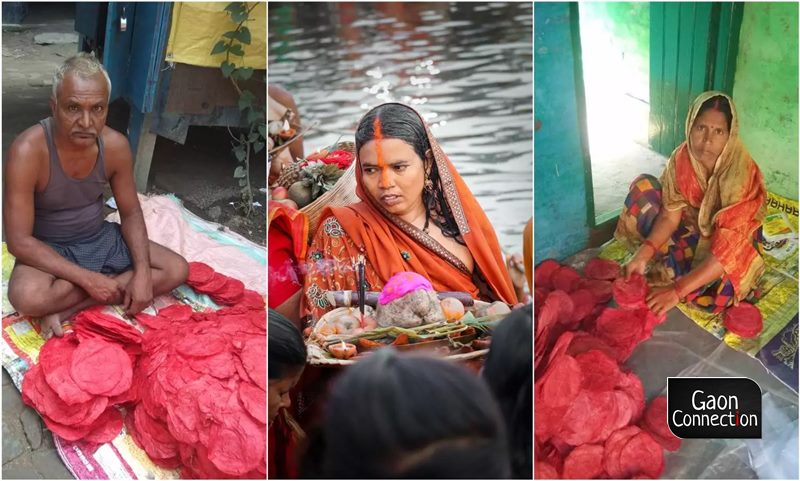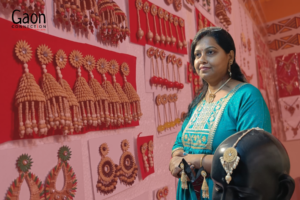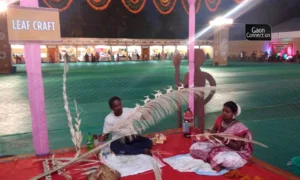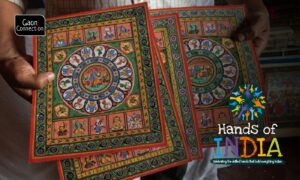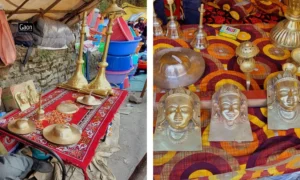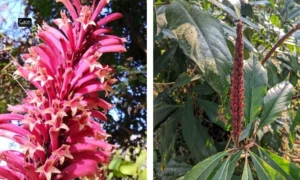Almost every household in Jhaua village in Bihar’s Saran district is busy making what looks like red coloured papads. They are actually aalta patra (also known as aarta paatr), an important element of the Chhath Puja, a four-day festival that is currently being observed.
Aalta patra is an offering to the Sun god, and is made of besan (gram flour) or maida (refined flour). Chhath Puja is celebrated to worship Sun and Chhathi Maiya — Goddess Usha from the Vedic period who is believed to be the consort of the Sun. These red coloured flat disks are also pasted on the doors and windows in the households during festivities.
The festival is widely celebrated in Bihar, Jharkhand, border areas in Uttar Pradesh and in Nepal as well.
Most of the people in Jhaua village and in the three other villages in the Dighwara block, with a total population of about 6000, are involved in making aalta patra.
Also Read: In Photos: From Nahay Khay to arghaya — how people in Bihar and Jharkhand celebrate Chhath Puja
The area is well known for its aalta patra for nearly eighty years now, and it is the main source of income for the inhabitants. A heartening fact is that both Hindus and Muslims make the aalta patra and nearly 70 per cent of them are women.
How an aalta patra is made
“Making the aalta patra is a laborious process. First acacia pods are broken up and the fibres from it are extracted. After this besan or maida is added to the fibres and then mixed with red colour and water and boiled and finally rolled out into the round shapes you see,” Bhagwan Das, who has been making them almost all his life, told Gaon Connection.
“It requires a lot of patience and time to make them, but we don’t earn anything much from it,” the 65-year-old said.
Once the aalta patras are made they are sunned on the terraces, front yards, and even the roads to dry before being bundled into sets of 20-50 and sent to the markets to sell.
Also Read: On Jur Sital, the Maithili New Year, the chulha maharani gets a break
“For a bundle of twenty aalta patra we earn twenty rupees. The bundle is sold in the market for forty rupees,” Rajkumar Das an aalta patra worker, told Gaon Connection.
“Each family spends about ten thousand rupees to buy the fibres of the acacia pods out of which they can make about thousand bundles,” the 45-year-old explained. “In a season a family earns anything up to twenty five thousand rupees,” he added.
The work on making aalta patras begins somewhere in July and carries on till Chhath Puja that follows Deepavali. As aalta patras are used in the pujas, the makers exercise the utmost devotion and hygiene while making them.
Mechanised aalta making
While a few have mechanised the aalta making by installing some machines, most of them still follow the age-old handmade techniques, he added. “Women will benefit the most from the help as they form the majority of the task force,” the aalta patra maker pointed out.
“Making the aalta patra involves a lot of physical labour. Sometimes we fall ill with the exertion of making them,” Geeta Devi, who has been on the job since she was married, told Gaon Connection. The 40-year-old said she had learnt the job from her parents-in-law. According to her, the fine fibres of the acacia have caused tuberculosis in many people.
Still, many people continue in this profession because there are no other sources of income available to them.
“I learnt the work from my grandparents and I continue to do it because I have to feed and clothe my four children,” Nisha Najbun, told Gaon Connection. She lost her husband 11 years ago, the 40-year-old said, and she runs her household with the money she earns making aalta patra.
Poorly paid
While there is not much profit for those who make the aalta patra, the middle men make a lot of money out of it.
“Those who sell the aalta patra to other states make a lot of money,” Anil Kumar, a local dealer who buys these patras from people like Nisha, told Gaon Connection. “I am a small dealer. I sell the patras to other districts such as Patna, Bhagalpur, Muzaffarpur, etc., and from there big dealers sell them to other states,” Anil Kumar explained.
Also Read: Uttarakhand’s Harela festival celebrates biodiversity, nature conservation and the monsoon
According to him, the workers depend heavily on small traders like him who give them money in advance that they use to make the aalta patra. He said he had invested about Rs 200,000 this season on this.
Also Read: Vocal For Local: An alliance with millets
Most of the aalta patra makers are landless people who have no other source of income. They take the money in advance from dealers like Anil Kumar and accordingly adjust the price at which they sell the finished product to him, and others like him.
Declare Aalta-making a cottage industry
According to aalta papad maker Bhagwan Das, a little help from the government by way of training and branding would go a long way in improving their earnings. “If the authorities enable some loans we can take to instal machines, we can do the work much faster and make more aalta patras and earn better,” he said.
“We take loans from local dealers which is not a very profitable deal for us,” Rajkumar Das, another aalta maker, told Gaon Connection. The aalta makers said that if the work they did was given the status of a cottage industry, it would greatly help them.
Also Read: Deepavali and lehyam love
“If what we do becomes a cottage industry, then getting loans from banks will get easier. We can then buy machines and increase our production two-fold,” Rajkumar Das said.
In a climate where ‘Vocal for Local’ and ‘Atmanirbhar Bharat’ are the rousing slogans, the aalta patra makers of Bihar hope someone will take note of their struggles too and help them keep alive this traditional craft associated with Chhath Puja. They are convinced that if aalta patra making is made more profitable to them, the youth will not migrate out of their villages looking for jobs.
Read the story in Hindi

